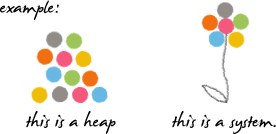Systems Thinking: The Common Sense, Next Big, Exciting Thing
Write it down. You heard it here first: Systems Thinking is the "next big thing" in education. Actually, it's already happening (PBS LearningMedia has a fabulous selection of classroom materials--check it out!) As systems educator Linda Booth Sweeney (think Angela Lee Duckworth and her "grit" big idea) says, systems shape us and surround us. Systems are "elements and processes interacting to form a whole."
In all honesty, systems thinking is common sense, at least to me. I think I am a born systems thinker. It's about understanding that A and B rarely exist together without impacting each other. A + B doesn't just equal AB. It usually equals C, and A + B + C = D, and so on. We don't just think about the parts: We think about how the parts are interconnected. Clear as mud?
Sweeney has a good example of explaining the difference between systems and non-systems. If you were to remove one element, one part of the collection of parts, will there be a change? For instance, if you were to remove the petals from a flower, the flower would most likely die. The petals are integral to the attraction of pollenating insects. Without them, the flower would not be pollenated. But if I removed one sock from my (enormous) pile of laundry, I still just have a pile of laundry that I still have the privilege of washing for my adorable family. See? Check out this nifty image from Linda Booth Sweeney:

Make sense?
Maybe you're unsure whether or not you think in systems. As outlined on Sweeney's website, there are 12 Habits of Mind for systems thinkers. A system thinker:
Sees the Whole: sees the world in terms of interrelated “wholes” or systems, rather than as single events, or snapshots;
Looks for Connections: assumes that nothing stands in isolation; and so tends to look for connections among nature, ourselves, people, problems, and events;
Pays Attention to Boundaries: “goes wide” (uses peripheral vision) to check the boundaries drawn around problems, knowing that systems are nested and how you define the system is critical to what you consider and don’t consider;
Changes Perspective: changes perspective to increase understanding, knowing that what we see depends on where we are in the system;
Looks for Stocks: knows that hidden accumulations (of knowledge, carbon dioxide, debt, and so on) can create delays and inertia;
Challenges Mental Models: challenges one’s own assumptions about how the world works (our mental models) — and looks for how they may limit thinking;
Anticipates Unintended Consequences: anticipates unintended consequences by tracing loops of cause and effect and always asking “what happens next?”
Looks for Change over Time: sees today’s events as a result of past trends and a harbinger of future ones;
Sees Self as Part of the System: looks for influences from within the system, focusing less on blame and more on how the structure (or set of interrelationships) may be influencing behavior;
Embraces Ambiguity: holds the tension of paradox and ambiguity, without trying to resolve it quickly;
Finds Leverage: knows that solutions may be far away from problems and looks for areas of leverage, where a small change can have a large impact on the whole system,
Watches for Win/Lose Attitudes: is wary of “win/lose” mindsets, knowing they usually makes matters worse in situations of high interdependence.
So outside of science, how is this valuable to my classroom or program?
It turns out, systems thinking has its whole own category in the OCTAE Employability Skills Framework right there under Workplace Skills. Employers want people who think in systems, who see and understand that their job is connected to more than just a paycheck. Instead, it is connected to other jobs, the company's goals, the industry's successes and failures. They want employees to look for changes over time, who are willing to entertain different perspectives, and who can see the whole instead of a sum of parts. That's how I became introduced to systems. I have been working on systems thinking curriculum for Kentucky Adult Education as part of their Moving Pathways Forward Pilot Project. And I am in love!
How can I teach systems? Modeling is a great place to begin. Start by demonstrating to students how many systems exist within your classroom, then within your school, then within your community. Don't just make lists: Make "casual loops" for students to see the circular pattern of parts, not the separation of them. Use the obvious systems, like the solar system or a local ecosystem, to show the relationship of all elements. The possibilities are endless!
I am extcited about systems. How are you already using systems in your classes or programs, and how can you increase student awareness?
For more great information on systems thinking, visit www.lindaboothsweeney.net.





